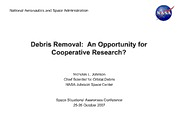
NASA Technical Reports Server (NTRS) 20070030088: Debris Removal: An Opportunity for Cooperative Research? PDF
Preview NASA Technical Reports Server (NTRS) 20070030088: Debris Removal: An Opportunity for Cooperative Research?
National Aeronautics and Space Administration Debris Removal: An Opportunity for Cooperative Research? Nicholas L. Johnson Chief Scientist for Orbital Debris NASA Johnson Space Center Space Situational Awareness Conference 25-26 October 2007 National Aeronautics and Space Administration Outline • Incentive for debris removal • Potential benefits of debris removal • Debris removal categories and concepts • Technical, Economic, and Legal Challenges 2 National Aeronautics and Space Administration Evolution of Satellite Population • The population of large objects in Earth orbit continues to grow. 12000 t i b r O h 10000 t r a E n i s 8000 t c e j b O d 6000 e g o l a t a C 4000 f o r e b m 2000 u N 0 7 1 5 9 3 7 1 5 9 3 7 1 5 5 6 6 6 7 7 8 8 8 9 9 0 0 9 9 9 9 9 9 9 9 9 9 9 0 0 1 1 1 1 1 1 1 1 1 1 1 2 2 3 National Aeronautics and Space Administration Projected Growth of LEO Populations (no new launches beyond 1/1/2006) 12000 Total Intacts + mission related debris ) O 10000 E Explosion fragments L m, Collision fragments c 0 1 8000 > ( s t c e j b O 6000 f o r e b m u 4000 N e v i t c e f 2000 f E 0 1950 1970 1990 2010 2030 2050 2070 2090 2110 2130 2150 2170 2190 2210 (Liou and Johnson 2006, 2007) Year • Collision fragments replace other decaying debris through the next 50 years, keeping the total population approximately constant • Beyond 2055, the rate of decaying debris decreases, leading to a net increase in the overall satellite population due to collisions 4 National Aeronautics and Space Administration What is the Future? • In reality, the situation will be worse than the “no new launches” scenario since – satellites continue to be launched into space – unexpected major breakups continue to occur • Postmission disposal (such as a 25-year decay rule) will help, but will be insufficient to prevent the self-generating phenomenon from happening. • To better limit the growth of the future debris population, active removal of existing objects from orbit should be considered. 5 National Aeronautics and Space Administration Potential Benefits of Active Debris Removal (ADR) 70000 Non-mitigation O) 60000 E ADR (2020/5) L m, ADR (2020/10) c 50000 0 ADR (2020/20) 1 > ( s t c 40000 e j b O f o 30000 r e b m u N 20000 e v i t c e ff 10000 E 0 1950 1970 1990 2010 2030 2050 2070 2090 2110 2130 2150 2170 2190 2210 Year • 2020/5: Five objects removed annually beginning in 2020 • 2020/10: Ten objects removed annually beginning in 2020 • 2020/20: Twenty objects removed annually beginning in 2020 6 National Aeronautics and Space Administration Debris Removal Curtails Future Collisions 180 160 Non-mitigation ADR (2020/5) 140 ADR (2020/10) s n 120 ADR (2020/20) o i s i l l o 100 C e v i 80 t a l u m 60 u C 40 20 0 2000 2020 2040 2060 2080 2100 2120 2140 2160 2180 2200 Year 7 National Aeronautics and Space Administration Mass in Orbit and Mass Removed 6.E+06 Mass in LEO (non-mitigation) Mass in LEO (ADR 2020/5) Mass in LEO (ADR 2020/10) 5.E+06 Mass in LEO (ADR 2020/20) Cum mass removed (ADR 2020/20) Cum mass removed (ADR 2020/10) 4.E+06 Cum mass removed (ADR 2020/5) ) g k ( s 3.E+06 s a M 2.E+06 1.E+06 0.E+00 1950 1970 1990 2010 2030 2050 2070 2090 2110 2130 2150 2170 2190 2210 Year 8 National Aeronautics and Space Administration Debris Removal Concept Principles • Must be technically feasible in the near-term. • Must be economically viable. – Affordable – Acceptable cost-benefit ratio • Must result in a meaningful improvement of the current or future near-Earth space environment. 9 National Aeronautics and Space Administration IAA Study Group • At 2006 International Astronautical Congress in Valencia, Spain, the International Academy of Astronautics (IAA) formed a study group on “Space Debris Environment Remediation”. • The primary goal of the study is to “examine the feasibility and effectiveness of space object removal to control the space debris environment”. • Intermediate goals include: – Identification and critical analysis of different techniques for removing mass from orbit – Investigation of legal aspects of the implementation of such techniques • Target final report date: mid 2009 10
